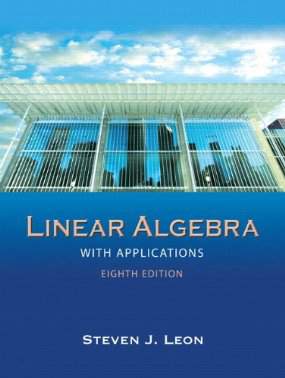Connecting...

This is a quick preview of the lesson. For full access, please Log In or Sign up.
For more information, please see full course syllabus of Linear Algebra
For more information, please see full course syllabus of Linear Algebra
Linear Algebra Inverse of a Matrix
Lecture Description
If you’ve been comparing g matrix properties and operations to numbers, then you might have considered what a matrix raised to the negative first power would look like. We’ll now show you how to find the inverse of a matrix as well as give you an example. There is something called the determinant, which we will get into later, that plays a big role in testing if an inverse of a matrix is possible. Not all matrices have inverses, and you can think of these matrices as the number zero; the inverse of zero is undefined as is the inverse of these special matrices.
Bookmark & Share
Embed
Share this knowledge with your friends!
Copy & Paste this embed code into your website’s HTML
Please ensure that your website editor is in text mode when you paste the code.(In Wordpress, the mode button is on the top right corner.)
×
Since this lesson is not free, only the preview will appear on your website.
- - Allow users to view the embedded video in full-size.
Next Lecture
Previous Lecture










































 Answer Engine
Answer Engine




1 answer
Sat May 22, 2021 12:13 AM
Post by Omear Saeed on May 20, 2021
Hi Prof Raffi, great course. Just wanted to check if you're following any particular book in terms of content structure? Thank you.
Kind regards,
1 answer
Fri Oct 11, 2013 9:17 PM
Post by Mohamed Badawy on October 8, 2013
I would like to note For the last example, during tests and exams I WILL NOT have the mathematical software. It would have been nice if you could show us this RRE rather than copying it off of your paper. Since this was a little more algebraically challenging with a variable in it.
thanks
2 answers
Last reply by: Christian Fischer
Wed Aug 28, 2013 1:17 AM
Post by Christian Fischer on August 27, 2013
Hi professor. I just gotta make sure I understand this:
A singular or trivial solution is Exactly this (ant nothing else)
(x1,x2,x3)=(0,0,0) Is that correct?
And a non-trivial solution is any other solution than a zero-vector?
(x1,x2,x3)=(x2-1, x2,0) for eksample?
2 answers
Last reply by: Manfred Berger
Thu Jun 6, 2013 7:42 AM
Post by Manfred Berger on June 5, 2013
Since you have just defined an inverse with respect to multiplication (at 6:44) you can in essence divide by non-singular matrices, can't you?
0 answers
Post by Real Schiran on April 8, 2012
Great Explanation . .Thanks
0 answers
Post by MAN UTD on March 14, 2012
That Was Fantastic Thanks Professor !=)
0 answers
Post by Stefán Berg Jansson on November 12, 2011
Would be awesome to have practice exercises to work with and nail the properties and Theorems down. Other than that, good stuff:)
1 answer
Sun Jul 15, 2012 7:16 PM
Post by Stefán Berg Jansson on November 12, 2011
Ops, after step 3 in "example:Finding Inverse" in row 3, column 3, 1 becomes 5.